The Peach is a deciduous tree grown for the edible fruit of the Rosaceae family. The Peach tree is relatively small, with slender and tender branches. Let’s check out the top 20 steps to boost Peach yield.
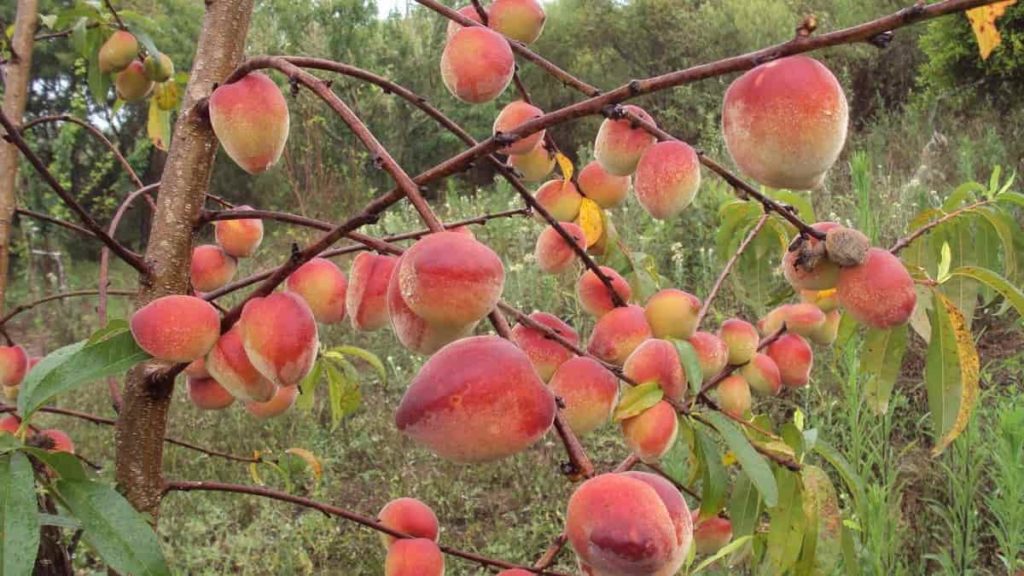
Top 20 steps to boost Peach yield
Step 1: Soil and light requirements for increasing crop yield
Peach trees need full sunshine. Growers in the shade lose their strength, causing them to suffer from pests and diseases. Peach trees need good drainage, and they like sandy soil. Adding an organic mulch around the tree, such as compost or leaf mold, helps suppress weeds and keeps the soil healthy.
Step 2: Land preparation for crop growth
Land should be prepared the same way as conventional field crops. It is essential to remove any broadleaf weeds or plants before planting Peaches. It is necessary to survey the nematodes before planting Peaches to determine if any treatment is needed to remove the harmful nematodes. If left untreated, nematodes can damage the root system of trees and stop or kill them before they bear fruit. It will result in uneven growth of trees and delay or decrease production.
In case you missed it: High Density Peach Planting – A Full Guide
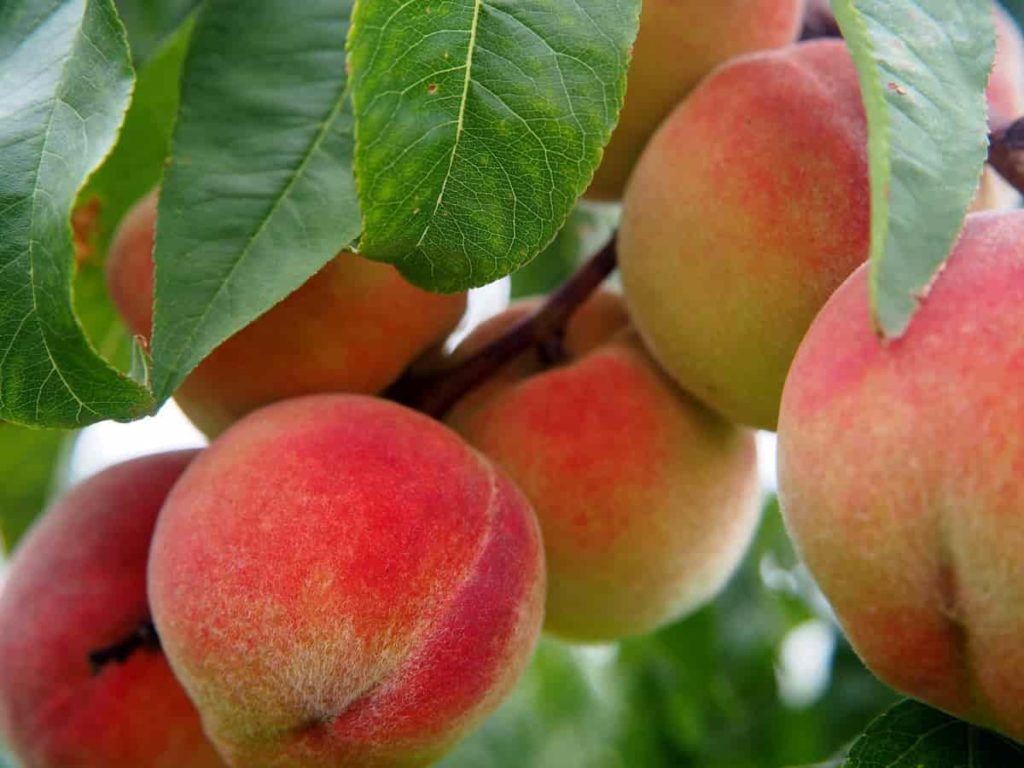
Step 3: Propagation method for increasing crop production
Peach trees are usually propagated vegetatively to maintain the desired genetic characteristic of the parents. T-budding generally propagates commercial trees in summer. T-budding involves adding a key of the selected type to the appropriate rootstock. The buds can also be collected late in the summer to emerge during the fall.
Budwood should be collected from healthy growing shoots of the current season, the leaves should be removed, and budwood should be kept moist till it merges with the rootstock. The rest of the tree is cut down to develop a new bud with the desired characteristics.
Step 4: Nutrients to get a sweet fruit
Nitrogen (N) is the needed nutrient, and the Peach tree is exported in large quantities. It directly affects plant growth, yield, and fruit quality, so nutritional balance is essential to ensure optimal nutritional balance, change the amount exported, and maintain the ratio between plant and reproductive growth. In addition to food, the timing of use and the arrangements adopted in the culture can also affect the applied nitrogen reaction.
Step 5: Peach tree fruit drop
Three main types of fruit fall from the Peach tree. The first is a natural disaster, the second is an environmental disturbance, and the third is related to pests or diseases. When the Peaches are ripe, they begin to fall naturally from the tree, but if the fruit is falling off early, it is essential to determine the causes of the fall and the problems to ensure the health of your crop. Control If there are too many fruits on the tree, it may be normal for the fruit to fall off the Peach tree.
In case you missed it: Peach Fruit Farming; Planting; Care; Harvesting
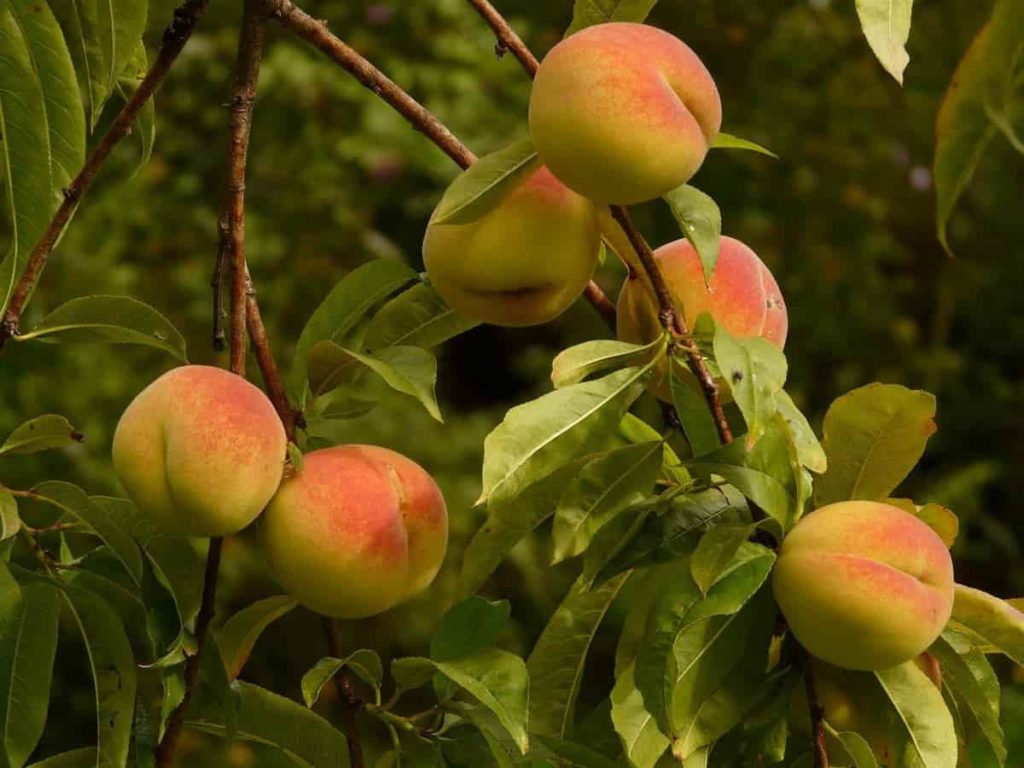
Dropping some fruit allows the tree to dedicate nutrients and water to the rest of the fruit. Start a balanced fertilizer program to increase the availability of nutrients for both trees and fruits. Avoid the flow of herbicides and apply pesticides only as directed; spray in the evening after returning to the hive. Suitable fruit cultivation methods will help ensure that the only Peach fruit that falls from the tree is what nature wants.
Step 6: Reasons for the thinning of the Peach tree
Every piece of fruit that lives on the tree should get its share of nutrients from the parent tree. Heavy branches deplete the tree’s resources and weaken it, making it more susceptible to disease and shortening its lifespan. When to thin a Peach tree depends on which method you choose. There are several ways to thin a Peach tree during the growing season, so you should look for a tree that fits your gardening schedule or try more than one. All are based on the natural growth and production of the tree.
Step 7: Thinning the Peach tree for increasing fruit size
To produce large Peaches with good color, it is necessary to thin out the number of flowers and small, immature fruits due to the lack of suitable chemical thinners. Proper thinning of the fruit divides the resources into smaller fruits, increasing the size of the fruit. The fruit should be spaced six to eight inches apart for most Peach varieties.
Thinning young Peaches
Thinning is an essential step in growing healthy, strong Peach trees that can maintain their fruit load. This process will increase the size and quality of the fruit. Leave behind the Peaches about 8 inches apart on the limbs. Thinning will not change the weight of the final crop, but it will help the Peach tree grow significantly larger fruits. It solves the problem of overloaded branches, which fall off before the fruit ripens.
Identifying mature Peaches
Some varieties of Peaches take longer to ripen than others. Many are expected in the early summer season, but others do not ripen until August or September. Clingstone Peach trees, which are early maturing, often bear smaller fruit than the freestone varieties. Remember that some tree parts will ripen faster than others; the inside branches will ripen five to 10 days after the outer parts.
Step 8: Plant spacing for getting more fruits
Plant spacing is essential for planting trees. Trees need space to spread their branches as they grow to full maturity. Standard-sized Peach trees can be planted 15 to 20 feet apart, while dwarf varieties should be planted 10 to 12 feet apart.
Step 9: Fertilization of Peach trees to produce quality fruit
Fertilizing Peach trees will go a long way in ensuring that they grow taller and have more Peaches. The best time to fertilize your Peach trees is in early spring. The nutritional requirements for Peach trees vary throughout their lives and are affected by rootstock, crop load, soil type, and climatic conditions. In addition to nitrogen, phosphorus, and potassium, Peach trees need adequate amounts of calcium, boron, copper, and zinc to maintain the tree’s health and produce quality fruit.
After planting, soil tests and leaf analysis are recommended at least once every three years. For best results, choose a fertilizer that is high in phosphorus and low in nitrogen. When fertilizing Peach trees in the backyard layout, consider the age and growth rate of the tree, soil/tissue analysis, and location. Because Peach trees do not bear fruit in the first two years after planting, mature fruit-bearing trees require less fertilizer than needed. Visual indicators, such as leaf color and poor growth, are symptoms of nutrient deficiencies.
In case you missed it: Top 15 Steps to Boost Litchi/Lychee Yield: How to Increase Fruit Size, Quality, and Production
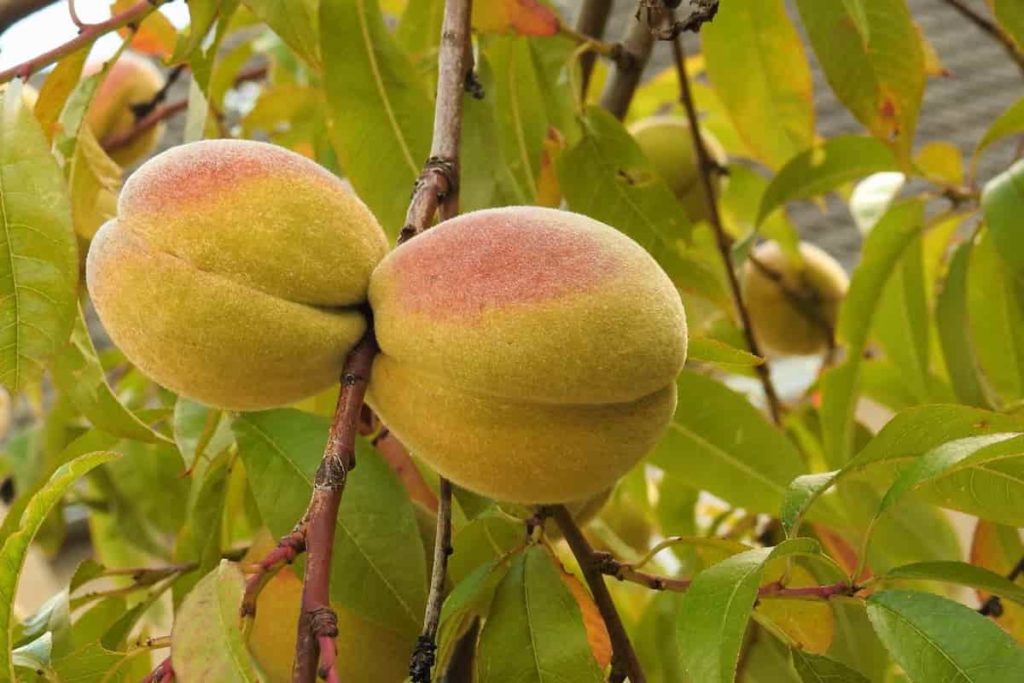
Fertilizers provide general guidelines for tree fertilization, including natural fertilizers. Mature Peach trees need mostly nitrogen (N) and potassium (K); these two nutrients are found in large quantities in fruits. Phosphorus stimulates root growth and is essential for young trees. Use complete fertilizer during the first three years of the tree, such as 16-4-8, 12-6-6, 12-4-8, or 10-10-10. Fertilize mature trees with pre-listed fertilizers or other N and K fertilizers such as potassium nitrate.
Step 10: Reasons for Peaches will not get bigger or ripen
Good fruit thinning techniques and growth conditions can help identify the specific source of your Peach tree problems.
Step 11: Weed control to get more fruits
Help your tree get off to a good start by reducing competition with herbs. Herbicides can be used underplanting rows while mowing between rows is sufficient and will keep the soil in place while reducing weed competition.
Step 12: Drip irrigation for fruit growth
Irrigation should be done immediately after planting. In the rainy season, these plants may not need water. Drip irrigation is the best way to use water efficiently. In case of drought, irrigation should be done at some critical stages. It is essential to water during the flowering/budding and fruit development stages.
Step 13: Caring for Peaches in subsequent years
Peaches are grown in summer with a mature Peach tree that requires 30-40 gallons of water each year. If the rainfall is not enough, you have to water the tree yourself. Examine the soil under the tree, and observe the wilting of the leaves. In the second year, fertilize Peach trees in the spring and summer with a complete formula containing minor elements. As always, follow the label instructions.
10-10-10 For fertilizer, you will apply about one cup (8 ounces) per application in the second year and then about two cups (about one pound) for every inch of trunk diameter. Never apply fertilizer in late summer or autumn as it can encourage new growth, which an early frost can damage. Mature trees should be cut down every year. They plant Peaches on last year’s fruitwood, and pruning stimulates new growth for next year’s crop. Always in winter when the tree is dormant but pruned before bud’s form.
In case you missed it: Top 20 Steps to Boost Almond Yield: How to Increase Fruit Size, Quality, and Production
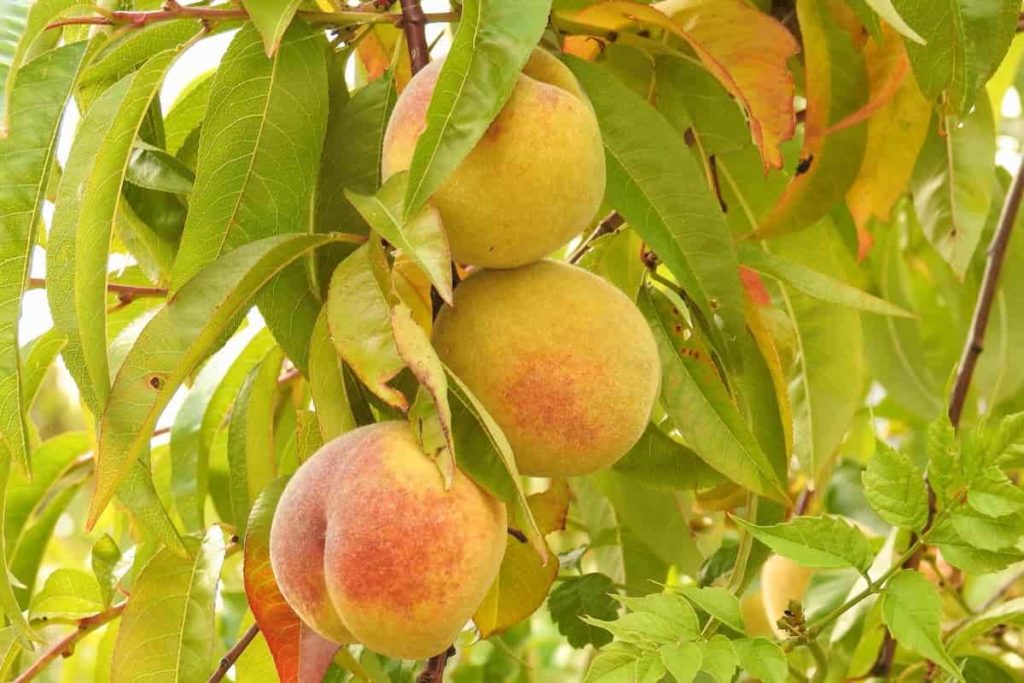
Step 14: Take care of the Peach tree to make big Peaches
If you want to increase the size of a Peach on an existing tree, you must carefully remember its moisture, light, pruning, and nutritional requirements. Keep the soil around the Peach trees well-drained and free of weeds. To improve drainage, modify the clay soil with equal parts of belly and sand. Peach trees will not grow in waterlogged soil and will bear little or no fruit. Make sure the Peach trees have adequate shelter from the cold winds.
Once a month, fertilize Peach trees with granular fertilizer containing nitrogen and potassium during the growing season. With summer pruning, prune the vertically growing twigs in the canopy of your Peach trees. Removing these strong plants will allow light to enter the canopy; the fruit will ripen inside the tree and help it grow. Water frequently and deeply during the last six weeks before harvesting. During this period, Peaches grow rapidly, and an increase in water causes the fruit to swell and grow bigger.
Step 15: Tips for getting large fruit
- Peaches need to be grown in a canopy area that gets about 20% full sun during the last three weeks before harvest to get the maximum possible size.
- Peaches that grow in the outer part of the tree receive bright light and ripen in the inner part of the tree several days before fruiting.
- The diameter of a Peach grows 2 to 4% on a tree every day. Delaying harvest as long as possible will improve fruit size.
Step 16: Reasons for Peach trees losing their leaves
Peach trees are leafy, naturally dropping their leaves every year. Therefore, leaf fall in late autumn or early winter is healthy and necessary. The Peach trees that lose their leaves at other times of the year may be due to some pest or disease.
Step 17: Why are the leaves of my Peach tree turning yellow?
The leaves of your Peach tree may turn yellow in the fall as part of their natural growth process. However, the yellow Peach tree leaves can also be a sign of trouble. For example;
- Giving too much water to your Peach tree or going underwater can cause its leaves to turn yellow.
- A lack of essential fertilizers in the soil can cause the leaves to turn yellow. Consider testing the soil to get an in-depth look at your tree’s soil.
- If the plants are planted too deep in the ground, the lack of oxygen will pressure the root system and cause premature leaf fall.
- Insect or leaf disease of a Peach tree can cause the leaves to turn yellow during the growing season.
Step 18: Treatment of plant diseases
Avoid Peach diseases like Peach scab and Peach leaf rust. Peach scab can negatively affect your pack out rate due to skin blemishes, while Peach leaf rust can cause early defoliation and bloom. This early blooming can reduce the crop load next spring. Many fungal diseases can affect Peach trees and cause the fruit to fall off early. Other fungal diseases that can affect your tree and its fruit include;
In case you missed it: District Wise Crop Production in Andhra Pradesh: Major Crops in Andra Pradesh
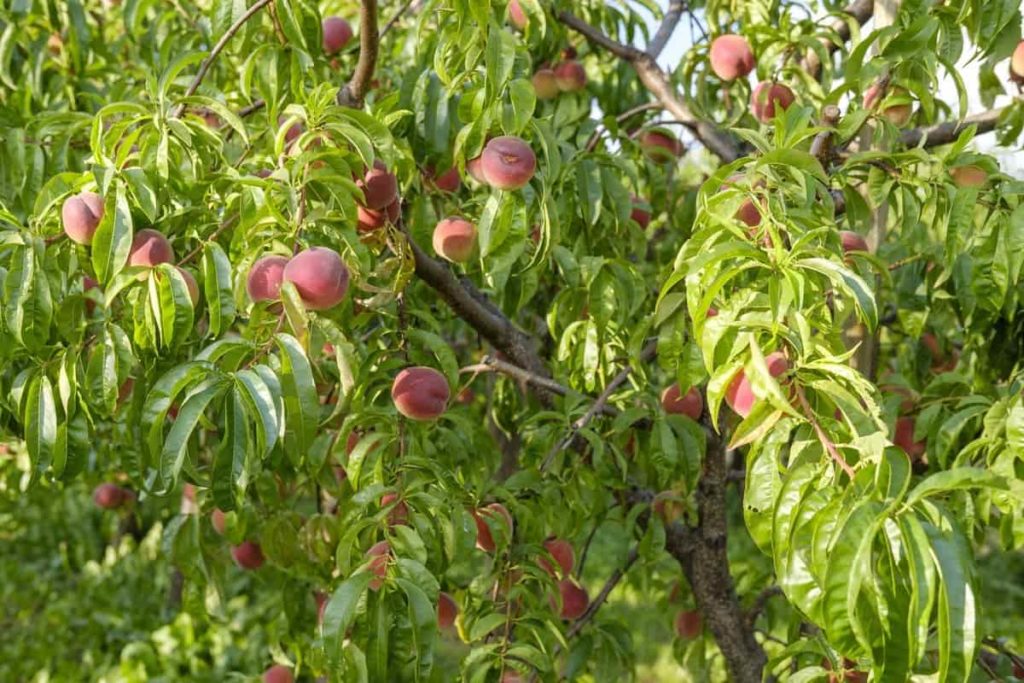
- Peach scab causes green scabs on the leaves and fruits.
- Leaf curl to curl, and leaves turn yellow or reddish
Treatment of these diseases is essential because fungal spores are flexible and can survive the winter to re-infect your tree in the spring. Spores can also be formed from wind and can affect neighboring trees. Prune the damaged and affected parts of the tree. Treat trees with fungicide. Some fungicides in residential areas include captan, chlorothalonil, copper, sulfur, and myclobutanil.
Step 19: HDP is essential for crop growth
HDP Peach trellis system
- This plant training system is very popular in high-density planting, and its production is very efficient. Trees are planted at a distance of 5×1 meters or 6×1 meters.
- The year-old plant is carried 20 cm above the ground level at the planting time.
- In the next growing season, two branches are selected in opposite directions, and branches are trained in the space between the rows at an angle of 60 degrees from the horizontal, forming a V-shaped canopy.
- The canopy is supported by a permanent trail of high tensile galvanized steel fence lines.
Step 20: Harvesting tips to get Peaches to have a sweet and full flavor
To make sure your Peaches have a sweet, full flavor, you must harvest them at the right time. Harvest time changes depending on the type of Peach but usually occurs from late June to August when the Peaches reach maturity. Fruit color is one of the best indicators of whether Peach fruits are ripe. When their outer skin is completely devoid of any green color, they are ready to pick. Choose one and taste it before harvesting the rest of your crop for the ultimate test.
- Economical Aquaculture: A Guide to Low-Budget Fish Farming
- 15 Common Planting Errors That Can Doom Your Fruit Trees
- How to Make Houseplants Bushy: Effective Tips and Ideas
- Innovative Strategies for Boosting Coconut Pollination and Yield
- Pollination Strategies for Maximum Pumpkin Yield
- The Complete Guide to Chicken Fattening: Strategies for Maximum Growth
- Natural Solutions for Tulip Problems: 100% Effective Remedies for Leaf and Bulb-Related Issues
- Revolutionizing Citrus Preservation: Towards a Healthier, Greener Future
- Natural Solutions for Peony Leaf and Flower Problems: 100% Effective Remedies
- Maximizing Profits with Avocado Contract Farming in India: A Comprehensive Guide
- Natural Solutions for Hydrangea Problems: 100% Effective Remedies for Leaf and Flowers
- The Ultimate Guide to Choosing the Perfect Foliage Friend: Bringing Life Indoors
- From Sunlight to Sustainability: 15 Ways to Use Solar Technology in Agriculture
- The Ultimate Guide to Dong Tao Chicken: Exploring from History to Raising
- The Eco-Friendly Makeover: How to Convert Your Unused Swimming Pool into a Fish Pond
- Mastering the Art of Delaware Chicken Farming: Essentials for Healthy Backyard Flocks
- 20 Best Homemade Fertilizers for Money Plant: DIY Recipes and Application Methods
- How to Craft a Comprehensive Free-Range Chicken Farming Business Plan
- Brighten Your Flock: Raising Easter Egger Chickens for Beauty and Bounty
- How to Optimize Your Poultry Egg Farm Business Plan with These Strategies
- Subsidy for Spirulina Cultivation: How Indian Government Schemes Encouraging Spirulina Farmers
- Ultimate Guide to Raising Dominique Chickens: Breeding, Feeding, Egg-Production, and Care
- Mastering the Art of Raising Jersey Giant Chickens: Care, Feeding, and More
- Ultimate Guide to Raising Legbar Chickens: Breeding, Farming Practices, Diet, Egg-Production
- How to Raise Welsummer Chickens: A Comprehensive Guide for Beginners
- How to Protect Indoor Plants in Winter: A Comprehensive Guide
- Ultimate Guide to Grow Bag Gardening: Tips, Tricks, and Planting Ideas for Urban Gardeners
- Guide to Lotus Cultivation: How to Propagate, Plant, Grow, Care, Cost, and Profit
- Agriculture Drone Subsidy Scheme: Government Kisan Subsidy, License, and How to Apply Online
- Ultimate Guide to Raising Araucana Chickens: Breed Profile, Farming Economics, Diet, and Care
- Bringing Hydroponics to Classroom: Importance, Benefits of Learning for School Students
- Ultimate Guide to Raising Polish Chickens: Breed Profile, Farming Economics, Diet, and Care
- Ultimate Guide to Raising Australorp Chickens: Profile, Farming Economics, Egg Production, Diet, and Care
- Silkie Chicken Farming: Raising Practices, Varieties, Egg Production, Diet, and Care
- Sussex Chicken Farming: Raising Practices, Varieties, Egg Production, Diet and Care
- Homemade Feed Formulations for Livestock: Discover Cost-effective Starter to Finisher Feed Recipes